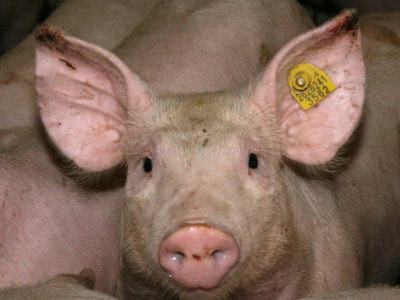What is ear necrosis?
Ear necrosis is a result of a reduced blood circulation in the ear, which causes the ear tip or edge to necrotize. Mild ear necrosis is characterized by small necrosis spots (blue black) at the tip of the ear. In severe cases, this leads to scabs and open wounds at both the ear tip and the ear edge. The condition is usually seen in weaned piglets during the summer period, but it can also occur during other seasons. Ear necrosis is a multi-factorial problem, making the cause difficult to define. The development of ear necrosis can in most cases not be linked to only one (exclusive) factor, but several factors play a role. These potential factors can be divided into infectious and non-infectious causes.

What are the potential causes of ear necrosis?
Mycotoxins and endotoxins as a potential cause of ear necrosis
Ergot alkaloids
Ergot alkaloids are mycotoxins produced as secondary metabolites by fungi of the genus Claviceps, which grow on crops in the field or develop during storage under poor conditions of crops and/or finished feed. They have a similar structure as some neurotransmitters such as norepinephrine and dopamine. Inhibition of the receptors of these neurotransmitters by ergot alkaloids results in the narrowing of blood vessels, restricting blood and oxygen supply to extremities and ultimately leading to the loss of ear tips.
Endotoxins
Deoxynivalenol (DON) is generally known for having a negative influence on the intestinal barrier of piglets. If this intestinal barrier is disrupted, endotoxins from the gastrointestinal tract can seep through the intestinal mucosa into the blood. Once endotoxins pass through the intestinal wall, they cause an inflammatory reaction which has an effect on the blood circulation of the animal. More specifically, the blood flow of the ears, the tail and the legs will be reduced resulting in necrosis. In addition to DON, several other risk factors can further increase the leakage of endotoxins along the intestinal wall, such as heat stress, weaning, feed transitions, the use of antibiotics, … .
Impact of ear necrosis
The majority of pigs showing signs of ear necrosis are 4 to 10 weeks old. Depending on multiple factors, outbreaks are often found in individual pens with more than 60 to 80% of pigs affected. Most of the lesions heal themselves after a couple of weeks leaving behind more or less serious damage on the whole ear. The impact on the growth of the pigs in those pens can be significant especially when the situation progresses to the biting of the damaged ears. In addition, pigs with damaged ears are best separated and treated with antimicrobials, adding to the cost of production. Moreover, there is a risk of developing septic arthritis or death from secondary bacterial septicemia. More than often farms struggling with ear necrosis show symptoms of tail necrosis which can be mistaken for tail biting or is potentiated by it. Tail necrosis and tail biting has become a very serious issue in EU since tail docking has been prohibited by the European Commission (European Union. Council Directive 2008/120/EC). Ear necrosis can increase the rate of carcass condemnations and can affect the pig price considerably as it is perceived as a health and welfare issue.
Prevention of ear necrosis

Given its multifactorial nature, ear necrosis is not an issue that can be solved overnight. However, preventing as many causes, such as mycotoxins and endotoxins, as possible is definitely part of the solution. Contact us for input on strategies to reduce the occurrence of ear necrosis, especially when ear necrosis is caused by mycotoxins present in the feed and/or the leakage of endotoxins from the gastrointestinal tract through a disrupted intestinal barrier.
References available upon request.
Contact us for more information!
